This Fideuà recipe (Catalan Paella with Pasta) is a deeply aromatic Spanish seafood dish that’s rich in warm and comforting flavors. Made with broken toasted spaghetti instead of rice, this seafood specialty is similar to a traditional paella and perfect for parties! Served with a tasty garlic aioli for topping.
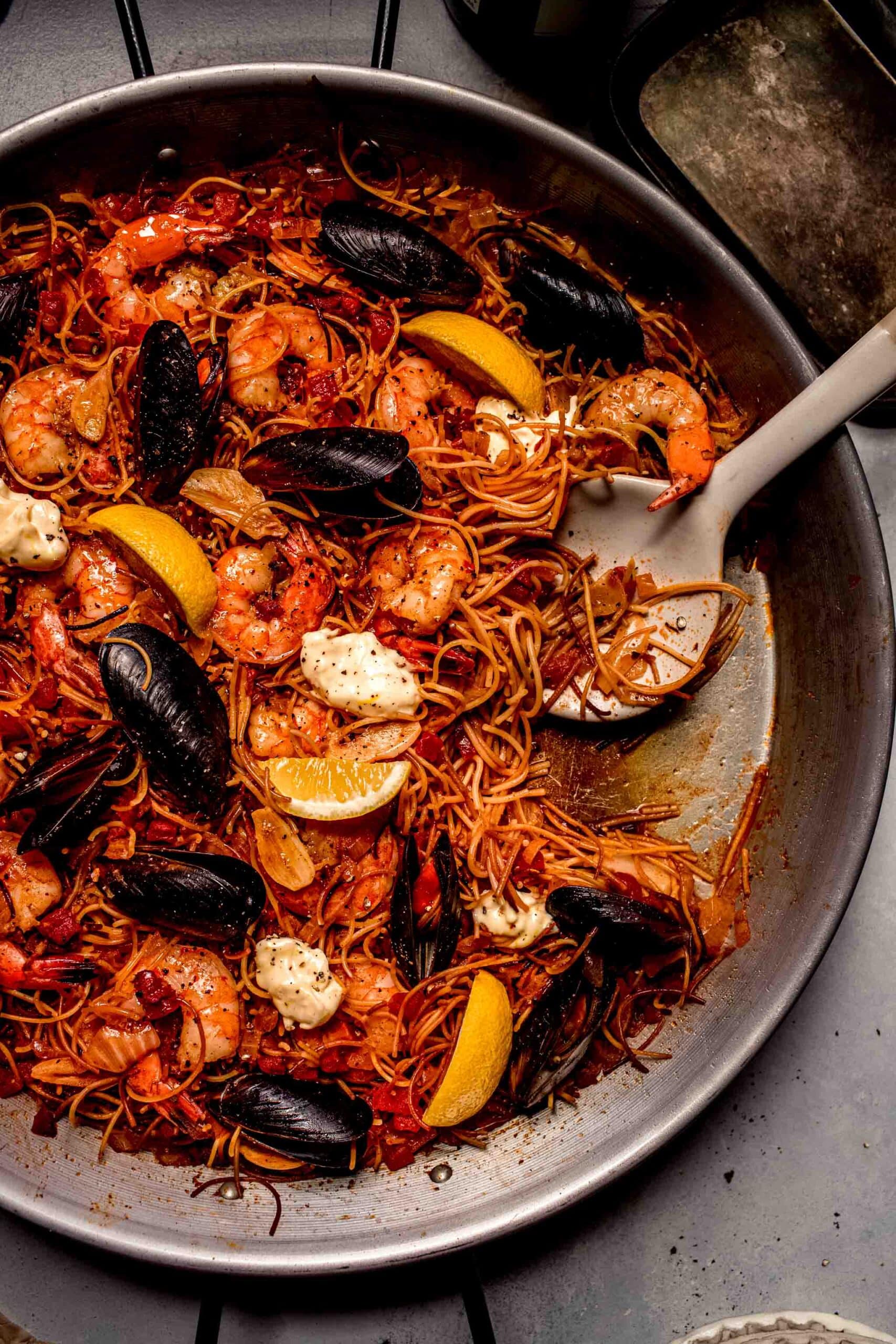
My heart belongs to Spain.
After traveling, eating, and wine tasting throughout the Mediterranean country in 2015, I vowed to bring my favorite parts home with me. That, of course, included vibrant and party-perfect meals!
Since that life-changing trip, I’ve recreated four of my favorite Spanish dishes:
- Pan Con Tomate (Spanish bruschetta)
- Seafood Paella
- Vegetarian Paella
- And this Fideuà (broken pasta paella) recipe
One bite and this easy fideuà recipe will transport you to Spain without having to pack a bag or sit through a long flight. It’s just like a traditional paella recipe but made with broken spaghetti instead of rice. The flavors are rich and comforting.
The best part? The recipe may look intimidating but the process is actually quite simple. Anyone can do it!
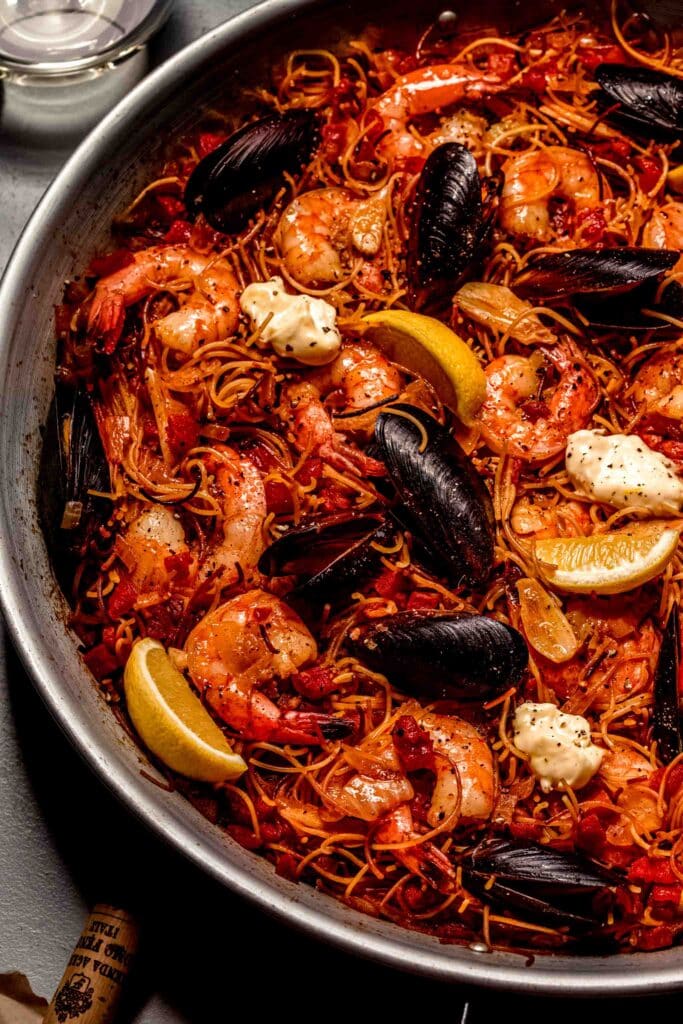
What is fideuà?
Fideuá (pronounced: feed-e-wah) is a Spanish seafood specialty and the perfect show-stopping one-pan dish to serve at your next party. Originating in the coastal Catalonia and Valencia regions of Spain, fideuá recipes showcase the best of fresh Mediterranean seafood.
It’s just like seafood paella, but with broken pasta instead of rice.
Fideuà roughly translates to “large amount of noodles”. For this Catalan paella, broken spaghetti noodles are standard. The rest of the dish is comprised of fresh ingredients, easy-to-find seafood, and lots of spice.
My fideuà recipe may be a simplified version of the traditional Spanish classic, but doesn’t lack in flavor!
What you need to make Catalan paella
- Fresh seafood – I used extra-large shrimp and mussels as they’re easy to source locally, but feel free to use what’s available to you.
- Seafood stock – You can also use chicken stock or my homemade bone broth.
- Aromatics – Diced tomatoes, onion, garlic, and plenty of paprika!
- White Wine (or dry vermouth) – To intensify every smoky, spicy, and savory note.
- Spaghetti noodles – Or any long, thin pasta like capellini or vermicelli. Or, you may be able to find fideua noodles in the store.
- Aioli – I make a quick “cheater” aioli in just 5-minutes by combining mayonnaise with garlic, lemon juice, saffron and a pinch of salt. Serve it on the side with your finished dish.
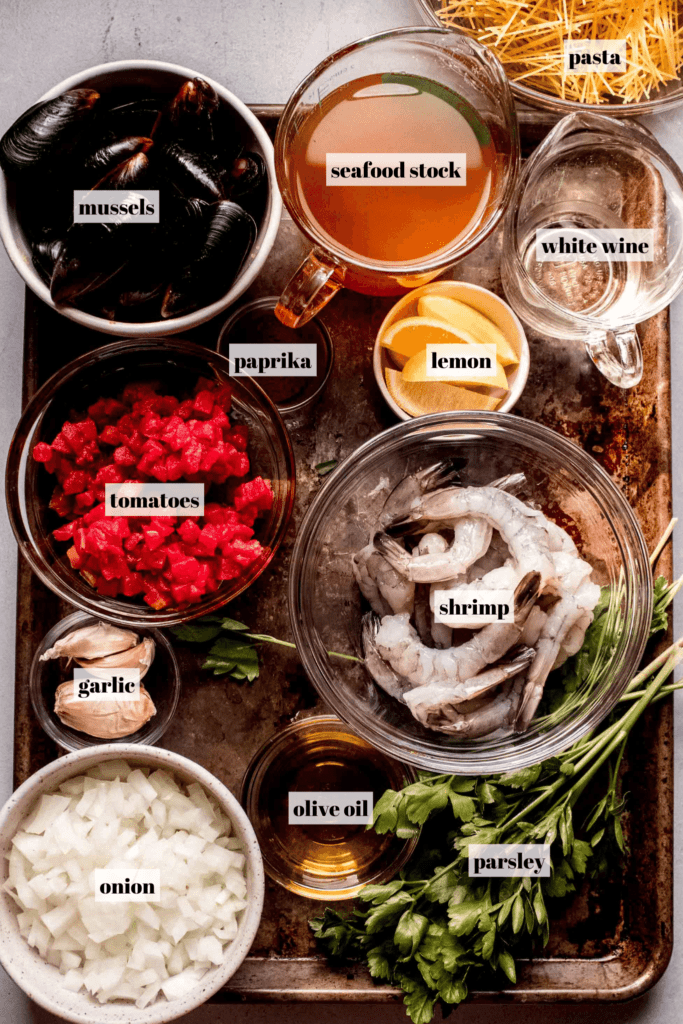
How to make fideuà
First, let’s marinate the shrimp. Toss peeled and deveined shrimp in a bowl with olive oil, garlic, salt & pepper. Cover and place it in the fridge.
While you’re waiting on the shrimp to marinate, heat the oil in a paella pan or large skillet. Add the broken spaghetti noodles and toast. Set aside and wipe the pan clean.
Next, saute the onions in the same pan. Add the drained tomatoes, then the paprika and garlic. Return the toasted noodles to the pan and toss. Add the seafood stock (or chicken broth) and wine and bringing it up to a simmer.
Now you can finally add the seafood! Nestle the marinated shrimp and mussels into the pan. Cook until the shrimp and opaque and the mussel shells have opened.
Meanwhile, make the quick aioli by combining mayonnaise, garlic, lemon juice and a pinch of salt and saffron (optional) in a small bowl and stirring to combine.
Sprinkle the finished noodles with fresh parsley and lemon, then serve with the aioli on the side or dolloped on top!
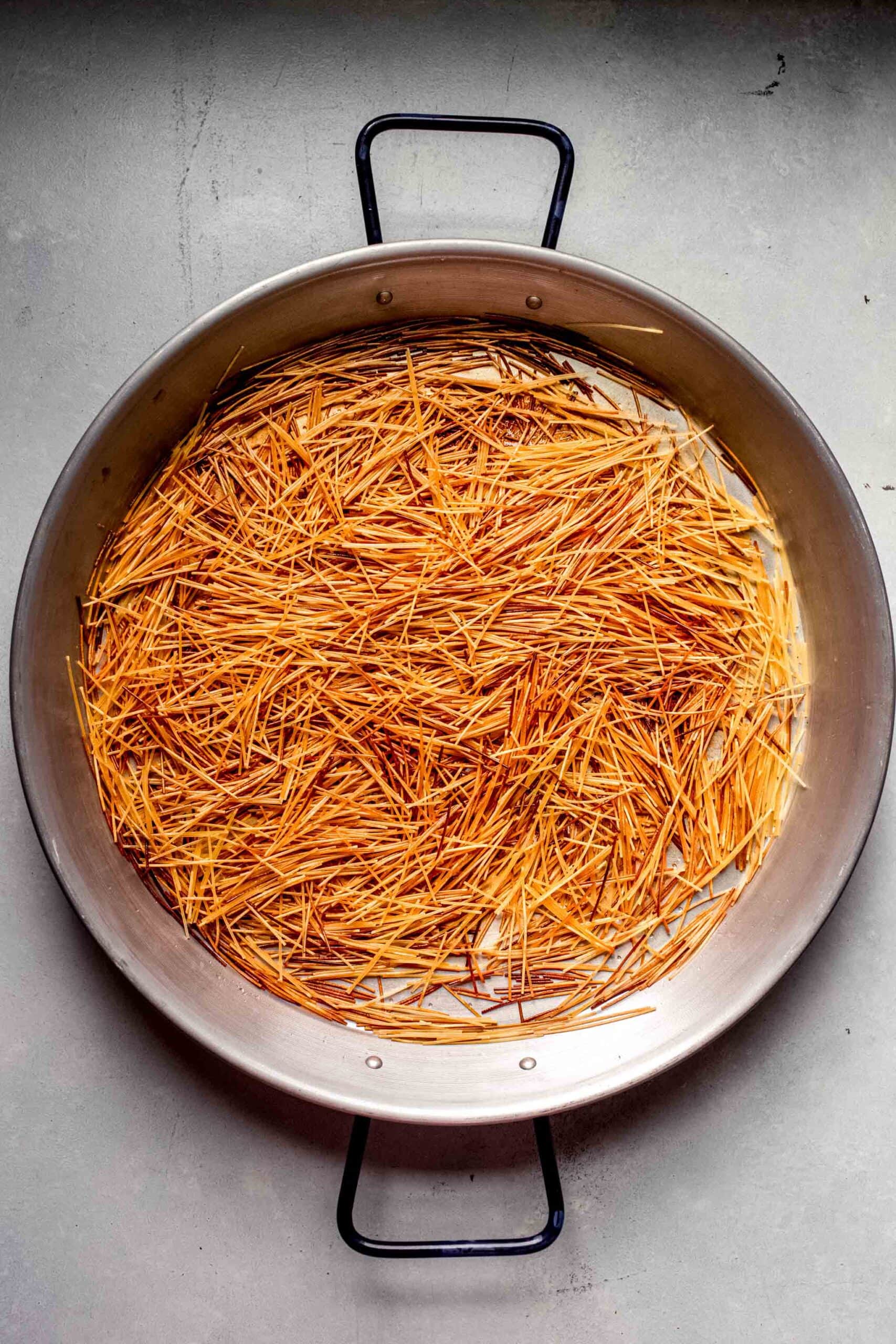

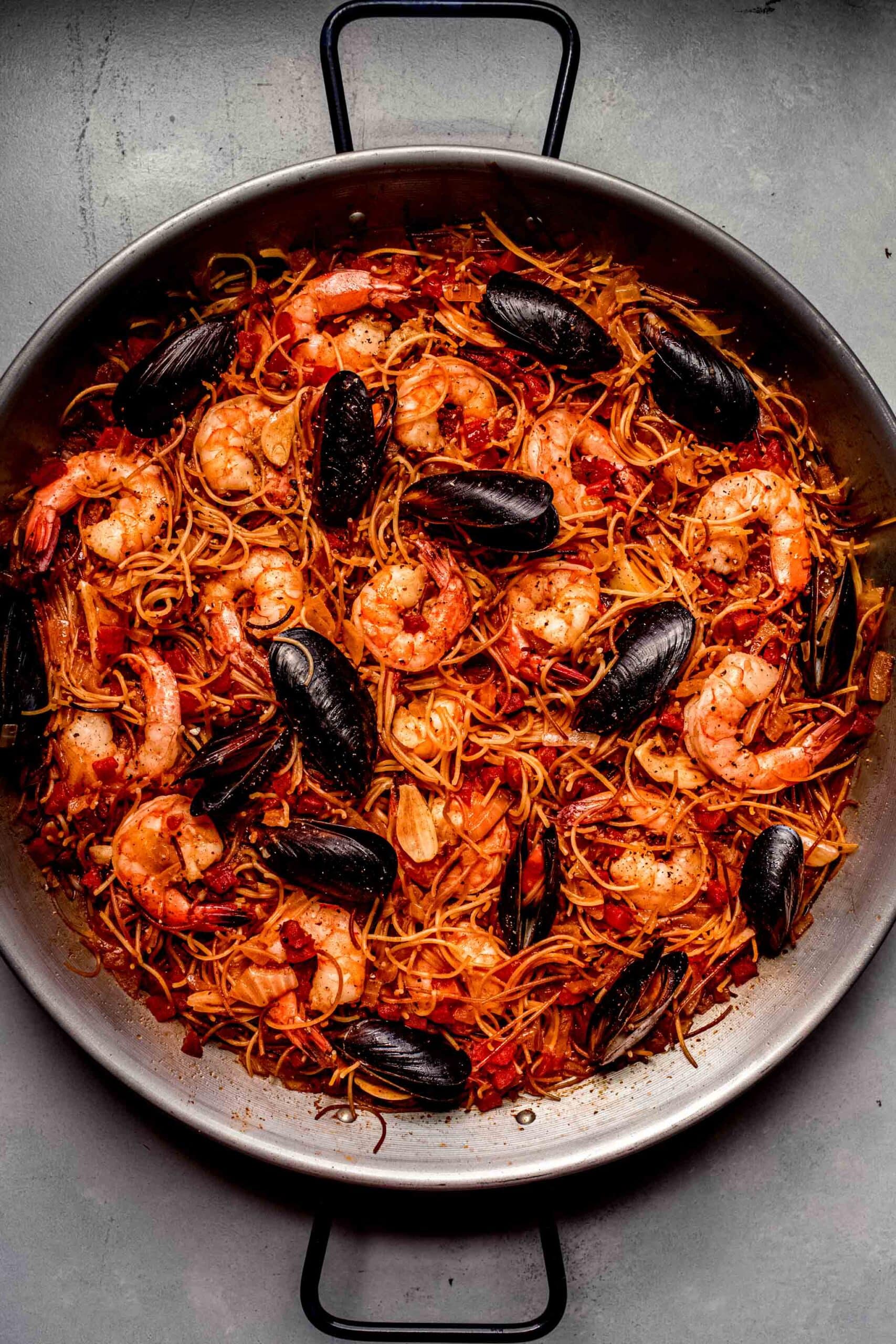
Tips and variations
- To break the spaghetti noodles, crush them gently in a resealable bag or between two towels. You want 1 to 2-inch pieces.
- A 15-inch paella pan is the pan of choice in this recipe. If you don’t have one, a large oven-safe skillet works just as well.
- Did some of your mussels not open? Toss ‘em. This means they aren’t safe to eat.
- If you’re not into seafood, you can cook seasoned chicken or chorizo separately and stir them in with the broken noodle pasta at the end.
- Want a vegetarian version? Or want to add more veggies? Towards the end of the cook time, just before the noodles are finished cooking, add in some frozen peas, fava beans, and/or artichoke hearts. And swap out the seafood stock for vegetable stock.
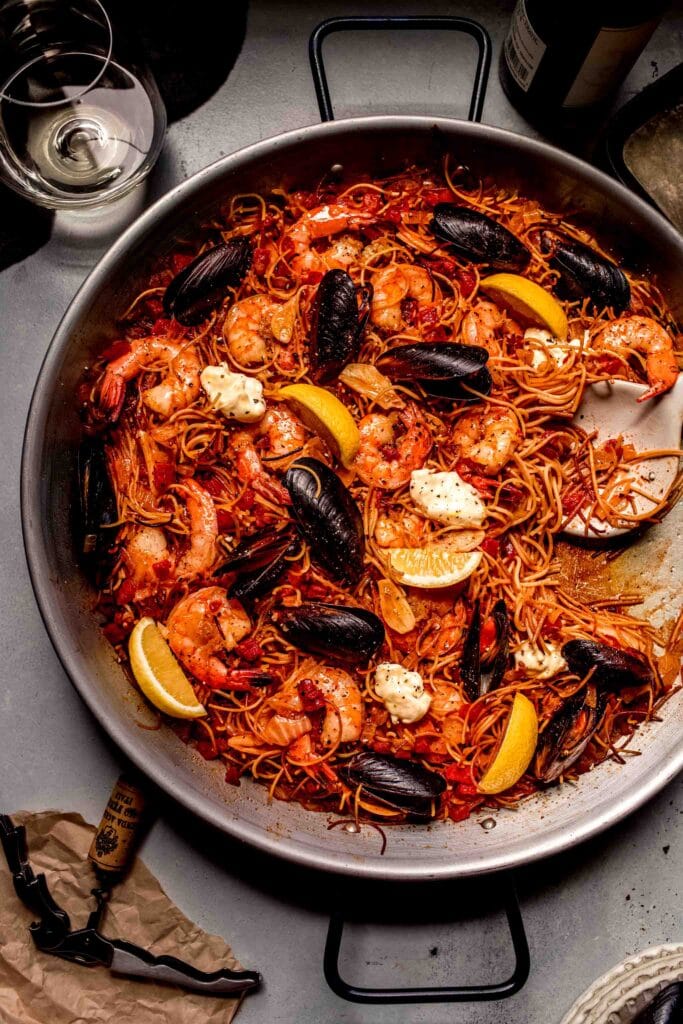
What is fideua traditionally served with?
Paella with pasta is a giant dish meant to feed a crowd, so the side dishes are typically light and healthy. Any of these sides would be well suited:
- Cherry Tomato Salad
- Pan Con Tomate
- Fried plantains
- Fresh tapas (like these Gilda Pintxo)
- Crusty bread
- Or, try one of these 30+ sides for paella!
- Plus, check out these 25+ Spanish desserts.
Wine pairings for fideuà
- Crisp white wines complement the tangy, briny flavors of seafood fideuà. Pair it with a rich, buttery Chardonnay or a sparkling white wine.
- If you’re leaning towards a red, go with something light like Pinot Noir or Garnacha.
- Would you prefer a specialty cocktail instead? Kalimotxo (or Calimocho) is a popular Spanish cocktail made with half cola, half red wine, and ice. It pairs perfectly with paella!
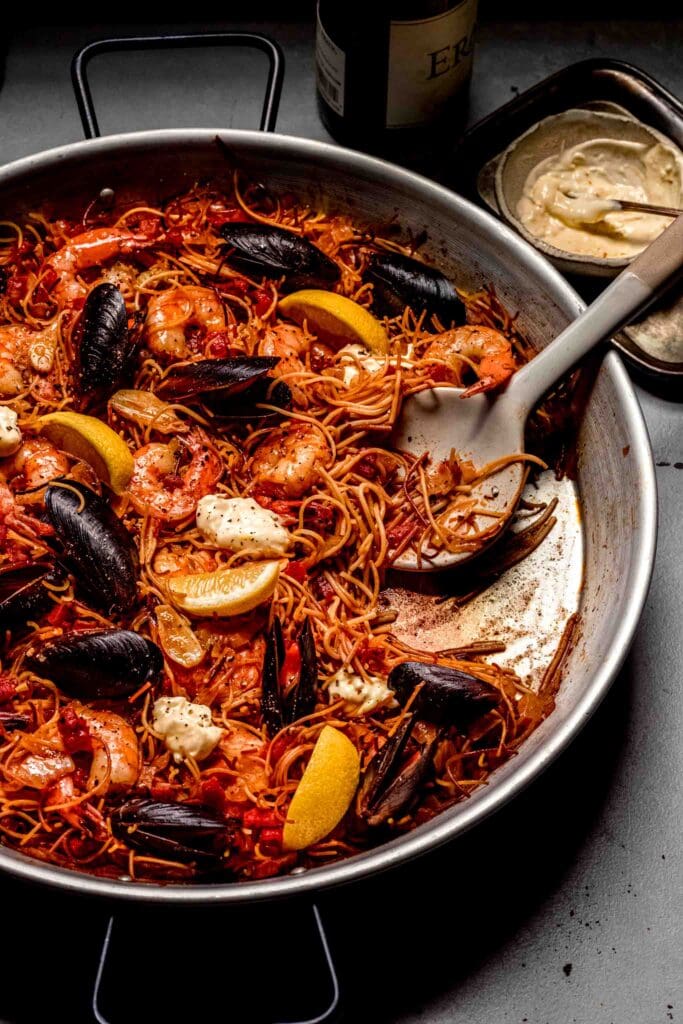
Did you make this Fideuà?
If you loved this easy Fideuà recipe, I would appreciate it so much if you would give it a star review! Also, be sure to snap a picture of your finished dish and share it with me on Instagram using the hashtag #platingsandpairings and tagging me @platingsandpairings.
For more great Platings and Pairings recipes, be sure to follow me on Instagram, TikTok, Pinterest and Facebook.
More comforting shrimp recipes:
- Shrimp Fra Diavolo
- Seafood Boil
- Squid Ink Pasta with Shrimp
- Easy Shrimp Piccata
- Shrimp Risotto
- Shrimp Biryani
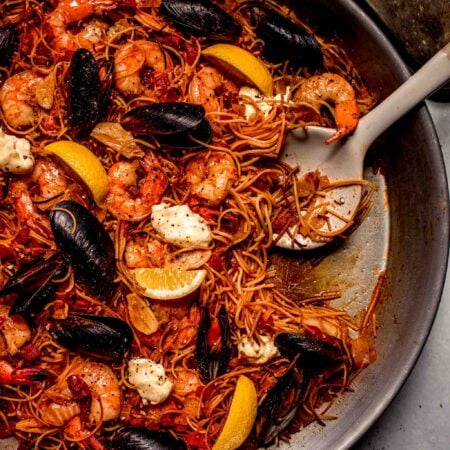
Fideuà Recipe (Pasta Paella)
Ingredients
- 1/2 pound extra-large shrimp (peeled (I like to leave the tails on) and deveined)
- 1/4 pound mussels
- 4 Tablespoons extra virgin olive oil
- 4 cloves garlic (divided (two minced + two sliced))
- 8 ounces thin spaghetti (or fideua noodles)
- 1 small onion (finely diced)
- 1 14.5 ounce can petite diced tomatoes
- 1 teaspoon paprika
- 1 teaspoon smoked paprika
- 2/3 cup white wine (or dry vermouth)
- 1-3 cups seafood stock (or chicken broth, as needed )
- Salt and pepper (to taste )
- ¼ cup chopped parsley (for garnish)
- Lemon wedges (for garnish)
Quick Aioli
- 1/4 cup mayonnaise
- 1 clove garlic (grated or minced)
- 1-2 TBSP lemon juice (to taste )
- Pinch saffron (optional)
- Pinch salt
Instructions
- Place the shrimp in a medium bowl, and toss with 1 TBSP oil, minced garlic, and a pinch of salt and pepper. Cover and place in fridge.
- Break the spaghetti into small pieces. You can either place it in a large Ziploc bag, or place it between two towels, and break with your hands. The pieces should be about 1-2 inches.
- Add 1 TBSP oil to a large skillet or paella pan and heat over medium heat. Add the broken spaghetti and toast until it’s dark in color, being sure to toss constantly. It should take about 5-8 minutes for the pieces to turn deep golden brown.
- Remove the spaghetti from the pan and set aside.
- Add the remaining 2 TBSP oil to the pan and heat over medium-high. Add the onions and a pinch of salt and sauté until they start to soften.
- Drain the can of tomatoes well, using a mesh strainer to push the juices out.
- Add the tomatoes to the onions and sauté another 3 minutes. Add both paprikas and sliced garlic.
- Add the toasted spaghetti back to the pan, along with the wine, seafood stock (and water if needed) to just cover the pasta. Season with a pinch of salt and pepper, toss to combine, and bring to a simmer.
- Nestle the marinated shrimp and mussels into the pan and cook for 6-8 minutes, or until the pasta is al dente, the shrimp are cooked though and the mussels have opened.
- Meanwhile, make the aioli by combining all ingredients in a small bowl and stirring to combine.
- Serve the fideuà garnished with chopped parsley, provide aioli and lemon wedges on the side. Enjoy!
Notes
- To break the spaghetti noodles, crush them gently in a resealable bag or between two towels. You want 1 to 2-inch pieces.
- A 15-inch paella pan is the pan of choice in this recipe. If you don’t have one, a large oven-safe skillet works just as well.
- Did some of your mussels not open? Toss ‘em. This means they aren’t safe to eat.
Equipment
Nutrition
This recipe was originally published in 2016. It was updated in 2022 to add new photographs, information, and to simplify the recipe a bit. Enjoy!


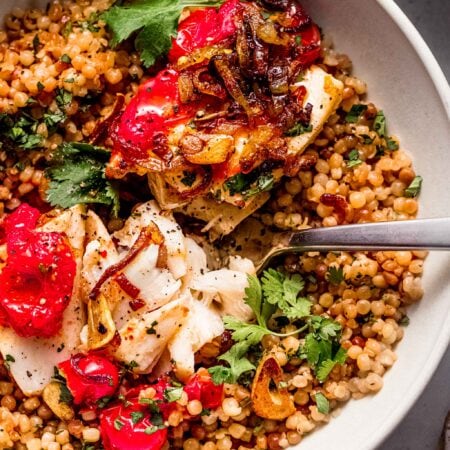
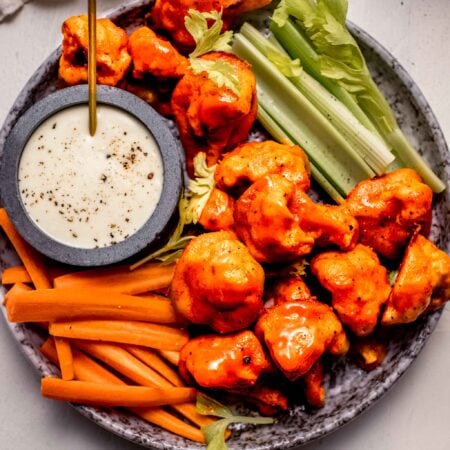
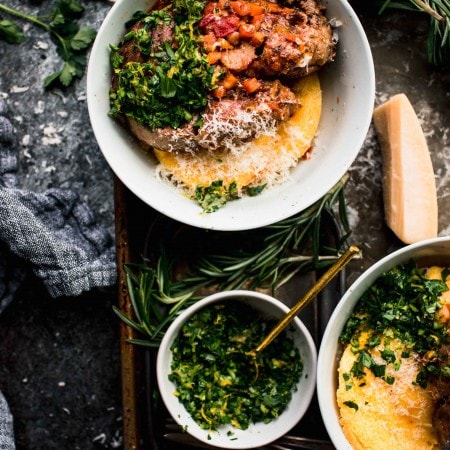
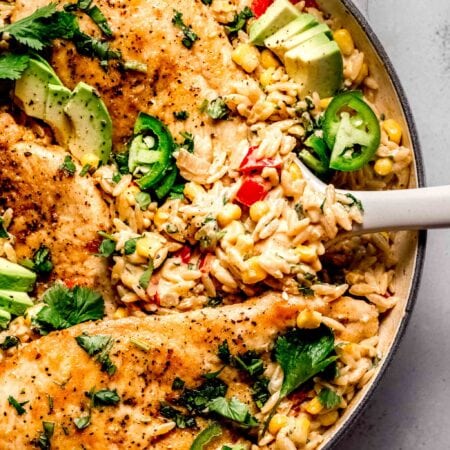
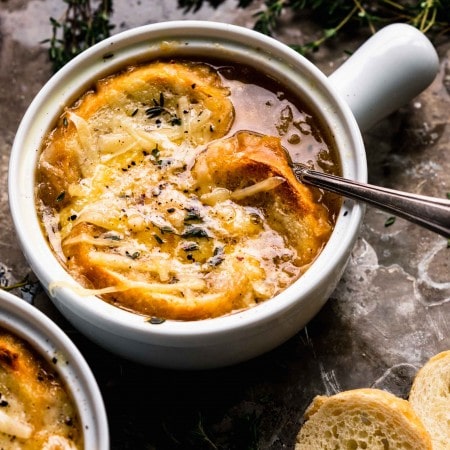
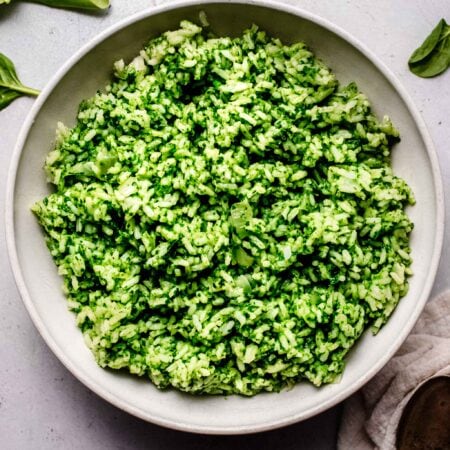
This is so. darn. gorgeous. I would be insanely impressed if I went to dinner at a friend’s house and she served this up!
You know I’ve never tried either of these recipes but they sound amazing! I love when you can recreate a food that brings you memories of a special trip too! #client
Thanks so much Kelly!
Yes. That is one pretty dish.
And I’ve never thought of mixing pinot noir + coke, but I’ve got to try that now.
Wine + Coke = Perfect for a warm spring day like today!
Your recipes are so complex and interesting!! Gorgeous photos! And this flavor combination sounds wonderful. I love the idea of making quick seafood stock. I don’t eat wheat but I bet it would be great with rice!
Thank you Suzannah! This would be equally as amazing with some rice 🙂 Or, check out my Paella recipe!
Paella is the ONE Basque heritage dish I wish I’d tried.
as delicious as this paella looks, I NEED to try that cocktail 🙂
I’m a huge fan of the Calimocho in the summertime – It makes it much easier to enjoy red wine when it’s 90 degrees outside!
How is the aioli used in the dish? Is it mixed in by the diner?
Hi Sabene – Yes, the aioli can be added to each serving individually, so that your guest can add as much or as little as they’d like 🙂
This looks SERIOUSLY delicious, Erin! I’m loving this pasta-filled take on a seafood favorite!
Thanks Ashley!
These photos are amazing!! I’ve always wanted to try my hand at making paella. I love Spanish food! I think once a year I have to do a small tapas party with friends just so I can get my fix. Boxed wine is absolutely the best wine to cook with in my opinion because I always want to drink my good bottles of wine (not use them in cooking!) but I also want a good quality wine for flavor while cooking. Black box makes great decent “house”” wines that are perfect for a daily glass or cooking. In addition- they last so much longer than a bottle!
A tapas party sounds like SO much fun! And, I’m totally agreeing with you on the Black Box. It makes a great EDD (every day drinker) and is perfect to have on hand for cooking “emergencies” too 🙂
I became a big paella fan too after our trip to Spain last year. And like you, I’ve been trying to recreate those fabulous Spanish flavours in different dishes ever since. There’s something about being there . . . This “twist’ on traditional paella sounds fabulous!
I miss Spain so much! It’s only been a few months since we were there, but I want to go back so badly!
Neither this recipe, nor the one you got it from mention what to do with the minced garlic. Looks great anyway though.
Hi Rob – The minced garlic is used in step 2, for the shrimp. Hope this helps!
Hi.
Fideuá is not catalan, but valencian (like paella)
https://en.wikipedia.org/wiki/Fideu%C3%A0
Exactly! That’s completely wrong information, both paella and Fideuà are not Catalan dishes but Valencian.